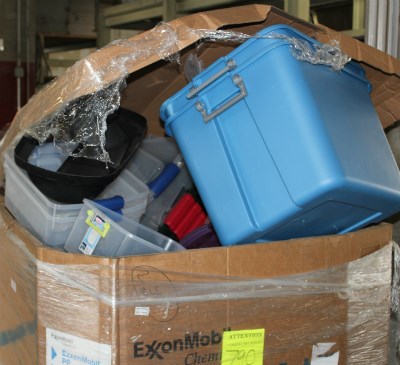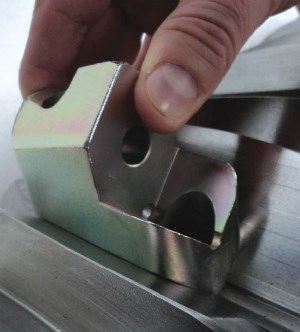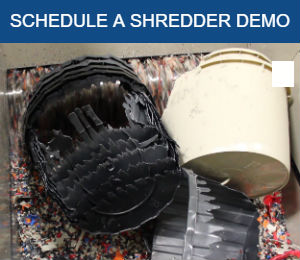Reclaim More Scrap, and Profits, with Industrial Plastic Shredders
Sponsored ContentMany plastics processors have granulators for recycling scrap. But for injection molders and extruders of large parts or dense materials, a plastics recycling shredder may be the better option for first-stage material size reduction.
Share

If you’re sending scrap to the landfill or recycling manually, it’s time to look at a shredder.
If you are like many plastics processors, you may have a granulator for recycling scrap, but may not think you need a shredder. Those are for the commercial recyclers and really high-volume processors, right?
Maybe not. If you do injection molding, blow molding, or extrusion of large parts or dense materials, and have to manually cut them up before feeding them to a granulator, you’re probably spending more on labor than you realize. It’s the same if you’re extruding film and need to unwind rolls to process them. Or if you’re sending your scrap to a landfill, it’s probably time to reconsider recycling before it’s forced upon you.
A plastics shredder can provide a cost-effective alternative in all these scenarios. It starts by investigating the payback and making sure you are looking at the best equipment for your application. For many plastics processors, successfully reclaiming scrap can make a substantial contribution in increasing profit. However, in order for scrap to retain its value—whether it is recycled back into the process or sold to others for recycling—it must be reduced to a manageable and uniform size.
That’s where granulation and shredding equipment come in.
With a shredder you can dump large, dense sheets of plastic or films and simply walk away.
Where Shredders Fit In: When to Use Them
If you just grind relatively small volumes of sprues, runners, off-spec parts and edge trim from film, the beside-the-machine granulator is the way to go. For higher volumes, maybe a central granulator makes sense. But when you have to chew through tough materials, large parts, rolls of film and other difficult materials, shredders can be easy to justify. This explains why shredders are so common in recycling applications involving wood, metal and paper and why they are increasingly popular in plastics recycling.
To evaluate your application, consider these factors:
Volume – Shredders lend themselves to higher volume applications. This is especially true of single-shaft shredders, which use a horizontal hydraulic ram to drive scrap material into the cutting area at the intersection of the rotor and the stationary knives. In fact, the more scrap there is in the feed bin and the heavier it is, the better it feeds into a shredder.
Density – Some scrap can put a considerable strain on size-reduction equipment. Purgings, which can be several inches thick and weigh thirty or forty pounds, are a good example. Some molders first cut them up with a band saw to recycle. With a shredder, you can just drop them whole into the feed bin. The same goes for off-spec rolls of film or fiber, or other forms of heavy, dense scrap that could do serious damage to a granulator.

A shredder can handle almost any plastic part or resin without the need to pre-cut or meter the material into the machine.
Feeding Method – With a granulator, flooding the cutting chamber with scrap can cause a variety of problems, so you often have to meter material in by hand. With a shredder, you can just drop most materials into the bin and walk away. This makes a shredder a “dump-and-forget” machine, which requires significantly less labor.
Final Material Condition
A shredder is going to typically output pieces of material from ½ - 2 in. in diameter, which is adequate if the material is going to be sent to a recycler. If the material is going to be returned to your process in an injection molding machine or extruder in a blend with virgin pellets, shredded scrap may need to go through a secondary granulation process in order to develop optimal size and uniformity.
What to Look for in a Shredder
There has been significant innovation in the industrial shredder industry. Now, more than ever, not all shredders are created equal, and certain product features can make a big difference in how easy and safe a machine is to operate and maintain, as well as its life expectancy. With a long history of manufacturing shredding equipment for several industries and numerous patents in the field, Republic Machine well addresses features and functions that are important to getting the most out of a shredder.

Republic Machine's Split-A-Part design significantly reduces shredder maintenance and changeover time, while eliminating most safety concerns and enclosed space issues.
Split-A-Part Design
Sooner or later a shredder is going to need maintenance, and it may more frequently require cleanout, particularly if you need to separate different scrap materials from one another. With a conventional machine design, that literally means climbing into the feed hopper to accomplish these tasks, which is time consuming and potentially dangerous.

With Republic Machine’s “Split-A-Part” design, however, the entire power frame assembly splits horizontally apart from the feed assembly frame. This gives the operator or maintenance personnel unencumbered access to the rotor as well as other internal machine components. As implied, the counter knives are fixed opposite the rotor, with the distance between the two referred to as the “cutting gap” which may need adjustment when changing over to different parts or materials. With the split-apart design, this gap can be adjusted much more quickly than with more conventional designs, which dramatically reduces changeover time as well as the time required to execute virtually any internal machine maintenance. Without this feature, a maintenance tech must literally crawl down into the chassis of the unit – which is unsafe, and often requires special confined space training, equipment and precautions.

A single-piece rotor offers more durable performance over the life of a shredder.
Single-Piece Rotor
The rotor is the costliest component of a shredder, and the one that takes most of the abuse. Replacing a damaged rotor is an extremely expensive and time-consuming proposition, so it needs to be as tough as possible. Some rotors are made of two or three pieces that are welded together. A better option is a single-piece rotor that is machined from a solid piece of steel, including the shaft, which is used in Republic Machine shredders. In fact, they are so confident in the durability of their rotors that they are guaranteed for the life of the machine from breakage.

Bolt-in toolholders simplify maintenance and enable the use of different types of cutters for different applications.
Bolt-In Toolholder
The highest wear parts in a shredder are the rotating cutters and the mating stationary counter knives through which the tools drive the material. Some toolholders are welded onto the rotor, which makes sharpening or replacement when they break a difficult and expensive proposition. Instead, Republic Machine uses bolt-in toolholders, simplifying maintenance and enabling the use of different types of cutters for different applications. Pockets for the cutters are machined right into the rotor, further strengthening the tools. Also, the detachable counter knives are reversible and sharpenable. These features all combine to enable the shredder to continue to operate at “like-new” performance levels over time without extended downtime for maintenance.
Zoidal Cutting

Zoidal cutting system
Republic Machine offers two configurations of rotor cutters; the traditional “Hawksbill” and several versions of the patented “Zoidal” cutting system. Hawksbill cutters have been around a long time and are very good at ripping up solid materials. The problem with these cutters is that films and fibers tend to snag on the point of the tool and then wind around the rotor, which require stopping the machine for cleaning.
For this reason, Republic Machine invented the Zoidal cutting system that presents a flat surface to the material. Besides being much less inclined to snag and wrap the material, Zoidal cutters are stronger and wear longer even with durable materials like construction sheets, trash bags, liners, covers, films, sheeting, tubing and shrink packaging. Moreover, each cutter has two cutting edges (front and back) and can be resharpened. Collectively, these attributes lower both maintenance and consumable costs.
Add Up the Advantages
There are still more factors that contribute to the total cost of ownership of a shredder. For example, Republic Machine’s ram feed system senses resistance and pressure and then automatically adjusts the amount of material being fed into the cutting area. It monitors heat problems as well. It also has a torque limiter that protects the direct drive system (motor and gearbox) should a jam occur.
Does a shredder eliminate the need for a granulator? Maybe, if you are just selling scrap, and want to make sure you get the best price for it. But if you routinely process regrind and if you are spending a lot of time and effort in manual size reduction activities, a shredder may still be a total-cost savior in addition to your granulator.
Go to Republic Machine for more information on shredders for plastics processing.




